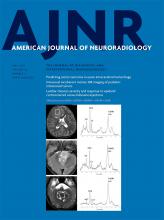Research ArticleAdult Brain
The Central Vein Sign in Radiologically Isolated Syndrome
S. Suthiphosuwan, P. Sati, M. Guenette, X. Montalban, D.S. Reich, A. Bharatha and J. Oh
American Journal of Neuroradiology May 2019, 40 (5) 776-783; DOI: https://doi.org/10.3174/ajnr.A6045
S. Suthiphosuwan
aFrom the Division of Neuroradiology (S.S., A.B.)
bDivision of Neurology (S.S., M.G., X.M., J.O.), Department of Medicine
P. Sati
dTranslational Neuroradiology Section (P.S., D.S.R.), National Institute of Neurological Disorders and Stroke, National Institutes of Health, Bethesda, Maryland
M. Guenette
bDivision of Neurology (S.S., M.G., X.M., J.O.), Department of Medicine
X. Montalban
bDivision of Neurology (S.S., M.G., X.M., J.O.), Department of Medicine
D.S. Reich
dTranslational Neuroradiology Section (P.S., D.S.R.), National Institute of Neurological Disorders and Stroke, National Institutes of Health, Bethesda, Maryland
eDepartment of Neurology (D.S.R., J.O.), Johns Hopkins University, Baltimore, Maryland.
A. Bharatha
aFrom the Division of Neuroradiology (S.S., A.B.)
cDivision of Neurosurgery (A.B.), Department of Surgery, St. Michael's Hospital, University of Toronto, Toronto, Ontario, Canada
J. Oh
bDivision of Neurology (S.S., M.G., X.M., J.O.), Department of Medicine
eDepartment of Neurology (D.S.R., J.O.), Johns Hopkins University, Baltimore, Maryland.

REFERENCES
- 1.↵
- 2.↵
- 3.↵
- 4.↵
- Polman CH,
- Reingold SC,
- Edan G, et al
- 5.↵
- Polman CH,
- Reingold SC,
- Banwell B, et al
- 6.↵
- 7.↵
- Tallantyre EC,
- Brookes MJ,
- Dixon JE, et al
- 8.↵
- Tallantyre EC,
- Dixon JE,
- Donaldson I, et al
- 9.↵
- 10.↵
- 11.↵
- Sati P,
- Oh J,
- Constable RT, et al
- 12.↵
- Sati P,
- George IC,
- Shea CD, et al
- 13.↵
- 14.↵
- 15.↵
- 16.↵
- 17.↵
- Miller AE,
- Calabresi PA
- 18.↵
- 19.↵
- Hosseini Z,
- Matusinec J,
- Rudko DA, et al
- 20.↵
- 21.↵
- 22.↵
- 23.↵
- Cortese R,
- Magnollay L,
- Tur C, et al
- 24.↵
- Okuda DT,
- Mowry EM,
- Beheshtian A, et al
- 25.↵
- Okuda DT,
- Siva A,
- Kantarci O, et al
- 26.↵
- Okuda DT,
- Mowry EM,
- Cree BA, et al
- 27.↵
- 28.↵
- Barkhof F,
- Filippi M,
- Miller DH, et al
- 29.↵
- 30.↵
- 31.↵
- Forslin Y,
- Granberg T,
- Jumah AA, et al
- 32.↵
- Alcaide-Leon P,
- Pauranik A,
- Alshafai L, et al
- 33.↵
- 34.↵
- Nair G,
- Absinta M,
- Reich DS
- 35.↵
- 36.↵
- Engell T
- 37.↵
- Gilbert JJ,
- Sadler M
- 38.↵
- Castaigne P,
- Lhermitte F,
- Escourolle R, et al
- 39.↵
- 40.↵
- 41.↵
- 42.↵
- Dworkin JD,
- Sati P,
- Solomon A, et al
- 43.↵
- Gaitń MI,
- de Alwis MP,
- Sati P, et al
In this issue
American Journal of Neuroradiology
Vol. 40, Issue 5
1 May 2019
Advertisement
S. Suthiphosuwan, P. Sati, M. Guenette, X. Montalban, D.S. Reich, A. Bharatha, J. Oh
The Central Vein Sign in Radiologically Isolated Syndrome
American Journal of Neuroradiology May 2019, 40 (5) 776-783; DOI: 10.3174/ajnr.A6045
0 Responses
Jump to section
Related Articles
- No related articles found.
Cited By...
This article has not yet been cited by articles in journals that are participating in Crossref Cited-by Linking.
More in this TOC Section
Similar Articles
Advertisement











